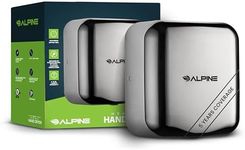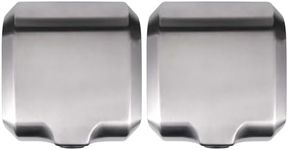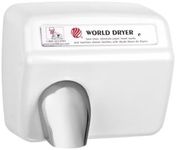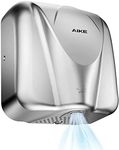Buying Guide for the Best Hand Dryers
Choosing the right hand dryer for your needs involves understanding various specifications and how they impact performance, efficiency, and user experience. Hand dryers come in different types and with various features, so it's important to consider where and how the dryer will be used. Here are some key specifications to help you make an informed decision.Drying TimeDrying time refers to how long it takes for the hand dryer to completely dry your hands. This is important because faster drying times can improve user satisfaction and reduce wait times, especially in high-traffic areas. Drying times typically range from 10 to 30 seconds. For busy places like airports or malls, a hand dryer with a drying time of 10-15 seconds is ideal. For less busy locations, a drying time of 20-30 seconds may be sufficient.
Power ConsumptionPower consumption indicates how much electricity the hand dryer uses. This is important for both environmental impact and operational costs. Power consumption is usually measured in watts (W). Hand dryers can range from 500W to 2000W. Lower wattage dryers (500W-1000W) are more energy-efficient and suitable for places where energy conservation is a priority. Higher wattage dryers (1500W-2000W) are more powerful and can dry hands faster, making them suitable for high-traffic areas.
Noise LevelNoise level measures how loud the hand dryer is when in operation, usually in decibels (dB). This is important for user comfort and to avoid noise pollution, especially in quiet environments like offices or libraries. Noise levels can range from 60dB to 90dB. For quiet environments, look for hand dryers with noise levels below 70dB. In noisier or more public areas, higher noise levels may be acceptable.
Hygiene FeaturesHygiene features include aspects like HEPA filters, antimicrobial coatings, and touchless operation. These are important for maintaining cleanliness and reducing the spread of germs. HEPA filters can capture airborne particles, making the air cleaner. Antimicrobial coatings can reduce the growth of bacteria on the dryer. Touchless operation minimizes contact, reducing the risk of contamination. If hygiene is a top priority, such as in hospitals or food preparation areas, look for hand dryers with these features.
Durability and Build QualityDurability and build quality refer to how well the hand dryer is constructed and how long it will last. This is important for long-term reliability and cost-effectiveness. Hand dryers can be made from materials like plastic, stainless steel, or aluminum. Stainless steel and aluminum are more durable and resistant to vandalism, making them suitable for high-traffic or public areas. Plastic models are generally less expensive and can be suitable for low-traffic areas.
Installation and MaintenanceInstallation and maintenance involve how easy it is to set up and keep the hand dryer in good working condition. This is important for minimizing downtime and maintenance costs. Some hand dryers are designed for easy installation and have features like removable parts for easy cleaning. Consider who will be installing and maintaining the dryer and choose a model that fits their capabilities. For example, a hand dryer with simple installation and low maintenance needs is ideal for small businesses or places without dedicated maintenance staff.



















